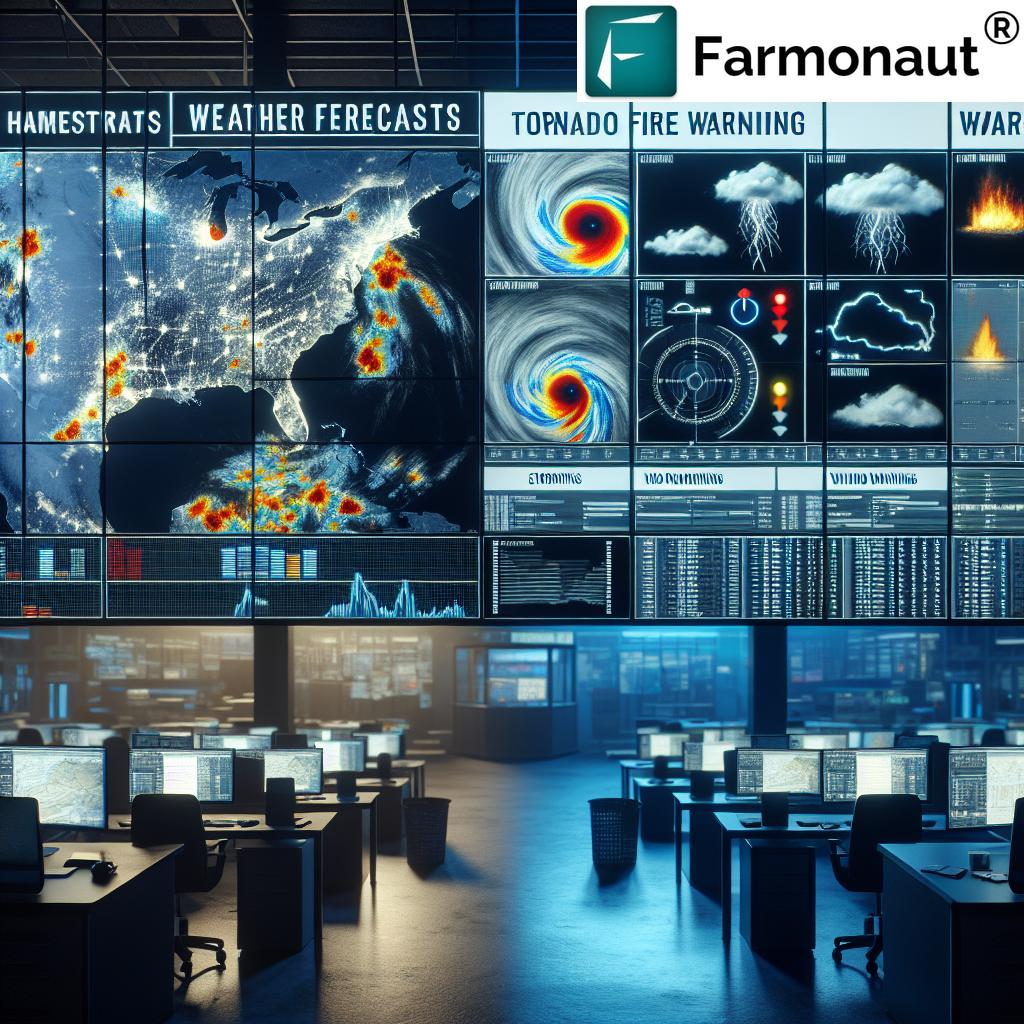Washington Weather Alert: How NOAA Job Cuts Impact Forecast Safety and Economic Sectors
“NOAA job cuts could impact forecasts for over 3,000 U.S. tornadoes annually, affecting millions of Americans’ safety.”
In a move that has sent shockwaves through the scientific community and raised concerns about public safety, the National Oceanic and Atmospheric Administration (NOAA) has recently announced significant job cuts. As we delve into this critical issue, we’ll explore how these reductions in workforce could potentially compromise weather forecasts, disaster response capabilities, and impact various economic sectors across the United States.
The Far-Reaching Implications of NOAA Job Cuts
NOAA, a pivotal agency responsible for providing crucial atmospheric data and issuing life-saving weather warnings, is facing a substantial reduction in its workforce. This decision has sparked a heated debate about the future of weather forecasting and its implications for public safety and the economy.
As we analyze the situation, it’s important to note that NOAA’s services extend far beyond daily weather reports. The agency plays a critical role in:
- Issuing extreme weather warnings
- Tracking hurricanes and other severe storms
- Supporting wildfire response efforts
- Providing essential data for various industries
- Ensuring maritime and aviation safety
The recent job cuts raise serious questions about NOAA’s ability to maintain the high standards of accuracy and timeliness in these critical areas.

The Voice of Concern: Scientists and Former Officials Speak Out
The scientific community and former NOAA officials have been vocal about their concerns regarding these job cuts. Admiral Tim Gallaudet, who served as NOAA’s acting chief under the Trump administration, warned that these layoffs could have severe consequences:
“It’s going to affect safety of flight, safety of shipping, safety of everyday Americans. Lives are at risk for sure.”
This sentiment is echoed by Rick Spinrad, a former NOAA Administrator, who highlighted the potential impact on critical seasonal forecasts:
“We’re getting into prime tornado time, we’re getting into planting season for the agricultural season. It’s going to affect safety. It’s going to affect the economy.”
These statements underscore the interconnectedness of NOAA’s services with various aspects of public safety and economic activity.
The Scale and Scope of NOAA’s Operations
To fully grasp the potential impact of these job cuts, it’s crucial to understand the scale and scope of NOAA’s operations:
- NOAA produces over 300 billion weather forecasts annually
- The agency’s forecasts reach 96% of American households
- NOAA operates 122 local offices across the country
- The agency issues critical warnings for tornadoes, hurricanes, wildfires, and floods
- NOAA provides seasonal forecasts for farmers and aviation weather alerts for pilots
Given this extensive reach, any reduction in NOAA’s workforce could have far-reaching consequences for public safety and various economic sectors.
Potential Impacts on Key Sectors
Let’s examine how the NOAA job cuts could affect different areas of public safety and the economy:
1. Tornado Season Preparedness
With tornado season approaching, the timing of these job cuts is particularly concerning. NOAA plays a crucial role in issuing timely tornado warnings, which are essential for saving lives. A reduction in staff could potentially lead to:
- Delayed warnings
- Less accurate forecasts
- Reduced capacity for real-time monitoring
As Ryan Maue, a conservative meteorologist and former NOAA chief scientist under Trump, pointed out:
“You can’t count on your weather app to call you up and alert you to a tornado.”
This highlights the irreplaceable role that NOAA plays in public safety during severe weather events.
2. Maritime Safety Forecasts
NOAA’s services are critical for maritime safety. The agency provides vital information for:
- Safe navigation in shipping channels
- Storm warnings for vessels at sea
- Oceanic data for the shipping industry
Admiral Gallaudet emphasized NOAA’s role in reopening the Baltimore port after the 2024 bridge collapse, demonstrating how the agency’s expertise is essential for maintaining the flow of maritime commerce.
3. Seasonal Forecasts for Farmers
The agricultural sector heavily relies on NOAA’s seasonal forecasts for planning and decision-making. These forecasts help farmers determine:
- Optimal planting times
- Crop selection based on predicted weather patterns
- Irrigation schedules
- Harvest timing
Any reduction in the accuracy or frequency of these forecasts could have significant economic implications for the agricultural sector.
“Weather agency layoffs may compromise maritime safety forecasts for approximately 95,000 miles of U.S. coastline.”
4. Aviation Safety
NOAA’s weather alerts are crucial for aviation safety. Pilots rely on accurate and timely information about:
- Turbulence
- Icing conditions
- Visibility
- Severe weather along flight paths
Any compromise in the quality or timeliness of this information could potentially impact flight safety and efficiency.
5. Wildfire Response
NOAA’s role in supporting wildfire response efforts is often overlooked but critically important. The agency provides:
- Fire weather forecasts
- Smoke dispersion models
- Data on wind patterns and humidity levels
These services are essential for firefighters and emergency responders in planning and executing their strategies to combat wildfires.

The Debate on Government Efficiency in Meteorology
While concerns about the impact of these job cuts are widespread, there’s also an ongoing debate about government efficiency in meteorology. Elon Musk, who leads the Department of Government Efficiency (DOGE), defended the NOAA firings, stating:
“The people voted for major government reform, and that’s what the people are going to get. That’s what democracy is all about.”
This perspective raises questions about balancing fiscal responsibility with the critical need for robust weather forecasting and warning systems.
The Role of Technology in Weather Forecasting
As we consider the impact of these job cuts, it’s important to acknowledge the role of technology in modern weather forecasting. Advanced satellite systems, AI-driven models, and big data analytics have revolutionized the field. However, experts argue that these technologies cannot entirely replace human expertise and judgment.
In this context, it’s worth noting how companies like Farmonaut are leveraging technology to provide valuable weather-related services to specific sectors. While not a replacement for NOAA’s comprehensive services, such technologies can complement and enhance weather forecasting capabilities.
Farmonaut, for instance, offers satellite-based crop health monitoring and AI-driven advisory systems that can help farmers make informed decisions based on weather patterns and crop conditions. While these services are valuable, they rely on the foundational data and forecasts provided by agencies like NOAA.
Farmonaut API and API Developer Docs offer ways for developers to integrate weather data into their applications, showcasing how private sector innovations can build upon public sector meteorological infrastructure.
The Economic Ripple Effect
The impact of NOAA job cuts extends beyond immediate safety concerns. Various economic sectors rely on NOAA’s data and forecasts for their operations. Let’s examine how these cuts could affect different industries:
1. Agriculture
Farmers depend on accurate seasonal forecasts for:
- Crop planning
- Resource allocation
- Risk management
Any reduction in forecast accuracy could lead to significant economic losses in the agricultural sector.
2. Transportation
Both maritime and aviation industries heavily rely on NOAA’s weather services for:
- Route planning
- Safety protocols
- Efficient operations
Compromised weather forecasts could lead to increased operational costs and potential safety risks.
3. Energy Sector
The energy industry uses NOAA’s data for:
- Predicting energy demand
- Planning for extreme weather events
- Optimizing renewable energy production
Inaccurate forecasts could result in inefficiencies and increased costs in energy production and distribution.
4. Retail and Consumer Goods
Many businesses adjust their inventory and marketing strategies based on weather forecasts. Reduced accuracy in these forecasts could lead to:
- Overstocking or understocking of seasonal items
- Misaligned marketing campaigns
- Lost sales opportunities
5. Insurance Industry
Insurance companies rely on NOAA’s data for:
- Risk assessment
- Policy pricing
- Claims verification
Less accurate weather data could lead to mispriced policies and increased financial risks for insurers.
| Weather Service | Current Capability | Projected Capability Post-Cuts | Estimated Economic Impact | Affected Industries |
|---|---|---|---|---|
| Tornado Warnings | High accuracy, timely alerts | Potential delays, reduced accuracy | High – Increased property damage, potential loss of life | Insurance, Construction, Emergency Services |
| Maritime Forecasts | Comprehensive coverage, frequent updates | Reduced coverage, less frequent updates | Medium – Increased shipping delays, safety risks | Shipping, Fishing, Offshore Energy |
| Seasonal Agricultural Predictions | Detailed long-term forecasts | Less detailed, potentially less accurate | High – Crop losses, inefficient resource allocation | Agriculture, Food Processing, Retail |
| Aviation Weather Alerts | Real-time updates, high precision | Possible delays in updates, reduced precision | Medium – Flight delays, increased fuel consumption | Airlines, Airports, Tourism |
| Wildfire Response Support | Detailed fire weather forecasts, smoke models | Less detailed forecasts, reduced modeling capability | High – Increased property damage, higher firefighting costs | Forestry, Emergency Services, Insurance |
The Role of Private Weather Services
As concerns about NOAA’s capacity grow, some may wonder if private weather services could fill the gap. While these services play an important role, experts caution that they cannot entirely replace NOAA’s functions:
- Private services often rely on NOAA’s raw data and models
- NOAA’s non-profit status allows for unbiased, widely accessible forecasts
- The agency’s nationwide network of weather stations provides comprehensive coverage
While private sector innovations like Farmonaut’s satellite-based crop monitoring can provide valuable specialized services, they complement rather than replace the fundamental role of national weather agencies.
The Human Element in Weather Forecasting
While technological advancements have significantly improved weather forecasting, the human element remains crucial. Experienced meteorologists provide:
- Interpretation of complex data
- Local knowledge and expertise
- Critical decision-making in high-stakes situations
As Keith Seitter, former director of the American Meteorological Society, noted:
“These are people who just live and breathe this work. People don’t go into meteorology to get rich. There will be things that fall through the cracks, and those things lead to situations that could be deadly.”
This highlights the importance of maintaining a skilled workforce in weather forecasting and analysis.
The Future of Weather Forecasting and Public Safety
As we look to the future, it’s clear that the debate over NOAA’s workforce and the future of weather forecasting in the United States is far from over. Key considerations include:
- Balancing budget constraints with public safety needs
- Integrating new technologies while maintaining human expertise
- Ensuring equitable access to critical weather information
- Preparing for increasingly extreme weather events due to climate change
The outcome of this situation will have lasting implications for public safety, economic sectors, and the field of meteorology as a whole.
The Importance of Continued Investment in Weather Services
As we navigate these challenges, it’s crucial to recognize the long-term value of robust weather forecasting services. Continued investment in this area can lead to:
- Improved public safety through more accurate and timely warnings
- Economic benefits across multiple sectors
- Better preparedness for climate change-related weather events
- Advancements in meteorological science and technology
While budget considerations are important, the potential costs of reduced weather forecasting capabilities could far outweigh any short-term savings.
Conclusion: A Call for Balanced Approach
The recent job cuts at NOAA have sparked a crucial debate about the future of weather forecasting and its impact on public safety and the economy. As we’ve explored, the consequences of these cuts could be far-reaching, affecting everything from tornado warnings to agricultural planning.
While there’s a push for government efficiency, it’s essential to strike a balance that doesn’t compromise the critical services provided by agencies like NOAA. The challenge lies in modernizing and optimizing these services while maintaining the expertise and capabilities that have made them indispensable.
As we move forward, it’s crucial for policymakers, scientists, and the public to engage in informed discussions about the value of weather services and the best ways to support and enhance them in the face of evolving challenges and technologies.
FAQ Section
1. How will NOAA job cuts affect daily weather forecasts?
Daily weather forecasts may become less accurate or detailed due to reduced staff and resources. This could lead to less precise temperature predictions, precipitation forecasts, and severe weather warnings.
2. Will these cuts impact hurricane tracking and warnings?
Yes, there’s potential for reduced accuracy in hurricane tracking and less frequent updates. This could affect evacuation plans and emergency preparedness in coastal areas.
3. How might farmers be affected by changes in NOAA’s services?
Farmers rely heavily on seasonal forecasts for planting and harvesting decisions. Less accurate or less frequent forecasts could lead to poor crop yields and economic losses in the agricultural sector.
4. Can private weather services replace NOAA’s functions?
While private services play a valuable role, they often rely on NOAA’s data and cannot fully replace its comprehensive, nationwide services and non-profit status.
5. How will these cuts affect climate change research?
NOAA plays a crucial role in climate research. Reduced staffing and resources could slow down important climate studies and long-term weather pattern analysis.
Earn With Farmonaut: Affiliate Program
Earn 20% recurring commission with Farmonaut’s affiliate program by sharing your promo code and helping farmers save 10%. Onboard 10 Elite farmers monthly to earn a minimum of $148,000 annually—start now and grow your income!
















